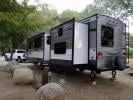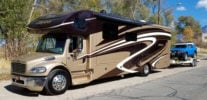 |
 11-03-2018, 01:04 PM
11-03-2018, 01:04 PM
|
#1
|
|
Senior Member
Join Date: Jul 2018
Location: Jackson Hole
Posts: 129
|
Batteries
During wineriztion I noticed the dealer wired my batteries in parallel as he should have but the RV wires only go to one. Everything Iíve seen online shows the pos (r) wire going to battery 1 and the ground (bk) going to #2.
See pic. Is this correct?
|

|

|
 11-03-2018, 01:24 PM
11-03-2018, 01:24 PM
|
#2
|
|
Senior Member
Join Date: Nov 2017
Location: anytown
Posts: 1,751
|
They are 12 volt batteries wired in parallel as they should be, you could change the wiring but it won't change the operation.
|

|

|
 11-03-2018, 02:17 PM
11-03-2018, 02:17 PM
|
#3
|
|
Senior Member
Join Date: May 2017
Location: Sweetwater
Posts: 731
|
I'm with 2008seneca. It's correct and no reason to wire it differently.
Carry on! 
__________________
- Jeff

2017 Jay Flight 32BHDS
2006 GMC 2500HD Classic CC SB 4x4 6.6L Duramax/Allison
|

|

|
 11-04-2018, 05:56 AM
11-04-2018, 05:56 AM
|
#4
|
|
Site Team
Join Date: Nov 2012
Location: Clearwater, FL area
Posts: 5,196
|
Your batteries are wired in the traditional manor. Since then, through some research, they have found that the traditional method is not the best for getting the most out of BOTH batteries. What was found was that when 2 batteries are hooked in parallel and the load's (TT service panel in our case) positive and negative connection are both connected to the same battery (battery #1), that battery is being hit for more Amps than the 2nd battery. Wait there is a solution to the problem... read on.
All you need to do is take the negative LOAD cables off of battery #1 and connect it to battery #2. Now what you have done is spread the load, almost equally, across both batteries. See the drawing below. In the below drawing there is a battery disconnect switch and it is wired to the negative cable. Should you decide to add a battery disconnect switch, it can be added to either the positive or negative cable. Some prefer the positive design some prefer the negative cable design. As I mentioned in another thread, if you put the switch on the negative cable, and forget to turn the switch on before traveling, your TT's electric emergency brakes will not operate, should the TT come lose from the TV while traveling.
Here is a link to better understand the reason for wiring the batteries in this manner. Read the 3 blue text documents.
Don
My Registry
RVing with SOLAR
|

|

|
 11-04-2018, 07:04 AM
11-04-2018, 07:04 AM
|
#5
|
|
Senior Member
Join Date: Nov 2011
Location: Where ever the boss says we're going.
Posts: 16,083
|
Quote:
Originally Posted by Mustang65

Your batteries are wired in the traditional manor. Since then, through some research, they have found that the traditional method is not the best for getting the most out of BOTH batteries. What was found was that when 2 batteries are hooked in parallel and the load's (TT service panel in our case) positive and negative connection are both connected to the same battery (battery #1), that battery is being hit for more Amps than the 2nd battery. Wait there is a solution to the problem... read on.
|
X-2. Few dealers connect them correctly.
|

|

|
 11-04-2018, 08:27 PM
11-04-2018, 08:27 PM
|
#6
|
|
Senior Member
Join Date: Jun 2013
Location: McKean, PA
Posts: 1,073
|
Is the same connection valid for battery tender connections for winter storage?
__________________
2011 Skylark 21FKV

|

|

|
 11-04-2018, 11:12 PM
11-04-2018, 11:12 PM
|
#7
|
|
Senior Member
Join Date: Apr 2016
Location: Kingman AZ and where our Seneca is today.
Posts: 3,118
|
Quote:
Originally Posted by Mustang65

Your batteries are wired in the traditional manor. Since then, through some research, they have found that the traditional method is not the best for getting the most out of BOTH batteries. What was found was that when 2 batteries are hooked in parallel and the load's (TT service panel in our case) positive and negative connection are both connected to the same battery (battery #1), that battery is being hit for more Amps than the 2nd battery. Wait there is a solution to the problem... read on.
All you need to do is take the negative LOAD cables off of battery #1 and connect it to battery #2. Now what you have done is spread the load, almost equally, across both batteries. See the drawing below. In the below drawing there is a battery disconnect switch and it is wired to the negative cable. Should you decide to add a battery disconnect switch, it can be added to either the positive or negative cable. Some prefer the positive design some prefer the negative cable design. As I mentioned in another thread, if you put the switch on the negative cable, and forget to turn the switch on before traveling, your TT's electric emergency brakes will not operate, should the TT come lose from the TV while traveling.
Here is a link to better understand the reason for wiring the batteries in this manner. Read the 3 blue text documents.
Don
My Registry
RVing with SOLAR |
X3 balancing all of the cells.
__________________
Steve & Stacy with Jasper (Australian Cattle dog)
2015 Seneca 36FK
Custom 27' flatbed trailer hauling:
07 Toyota FJC & Yamaha Kodiak 400 ATV

|

|

|
 11-05-2018, 11:37 AM
11-05-2018, 11:37 AM
|
#8
|
|
Site Team
Join Date: Nov 2012
Location: Clearwater, FL area
Posts: 5,196
|
Quote:
Originally Posted by us71na

Is the same connection valid for battery tender connections for winter storage?
|
Yes, the positive wire from the Battery Tender gets hooked to the battery with the load on the positive terminal . The Battery Tender negative wire goes to the battery that has the negative terminal going to the frame.
Don
My Registry
RVing with SOLAR
|

|

|
 11-05-2018, 12:43 PM
11-05-2018, 12:43 PM
|
#9
|
|
Senior Member
Join Date: May 2016
Location: Way down here........FL
Posts: 2,097
|
Quote:
Originally Posted by Mustang65

Your batteries are wired in the traditional manor. Since then, through some research, they have found that the traditional method is not the best for getting the most out of BOTH batteries. What was found was that when 2 batteries are hooked in parallel and the load's (TT service panel in our case) positive and negative connection are both connected to the same battery (battery #1), that battery is being hit for more Amps than the 2nd battery. Wait there is a solution to the problem... read on.
All you need to do is take the negative LOAD cables off of battery #1 and connect it to battery #2. Now what you have done is spread the load, almost equally, across both batteries. See the drawing below. In the below drawing there is a battery disconnect switch and it is wired to the negative cable. Should you decide to add a battery disconnect switch, it can be added to either the positive or negative cable. Some prefer the positive design some prefer the negative cable design. As I mentioned in another thread, if you put the switch on the negative cable, and forget to turn the switch on before traveling, your TT's electric emergency brakes will not operate, should the TT come lose from the TV while traveling.
Here is a link to better understand the reason for wiring the batteries in this manner. Read the 3 blue text documents.
Don
My Registry
RVing with SOLAR |
Mustang knows his STUFF!! Better listen to him 🙃
|

|

|
 11-05-2018, 01:55 PM
11-05-2018, 01:55 PM
|
#10
|
|
Senior Member
Join Date: May 2017
Location: Sweetwater
Posts: 731
|
Quote:
Originally Posted by jasum

Mustang knows his STUFF!! Better listen to him 🙃
|
Indeed! 
__________________
- Jeff

2017 Jay Flight 32BHDS
2006 GMC 2500HD Classic CC SB 4x4 6.6L Duramax/Allison
|

|

|
 11-06-2018, 09:10 PM
11-06-2018, 09:10 PM
|
#11
|
|
Senior Member
Join Date: Jun 2013
Location: McKean, PA
Posts: 1,073
|
Quote:
Originally Posted by Mustang65

Yes, the positive wire from the Battery Tender gets hooked to the battery with the load on the positive terminal . The Battery Tender negative wire goes to the battery that has the negative terminal going to the frame.
Don
My Registry
RVing with SOLAR |
Does this apply if the batteries are not connected to anything except each other and the charger?
__________________
2011 Skylark 21FKV

|

|

|
 11-07-2018, 06:30 AM
11-07-2018, 06:30 AM
|
#12
|
|
Site Team
Join Date: Nov 2012
Location: Clearwater, FL area
Posts: 5,196
|
Quote:
Originally Posted by us71na

Does this apply if the batteries are not connected to anything except each other and the charger?
|
Yes, it distributes the trickle charge evenly across both batteries.
Don
My Registry
RVing with SOLAR
|

|

|
 11-28-2018, 03:44 PM
11-28-2018, 03:44 PM
|
#13
|
|
Junior Member
Join Date: May 2016
Location: Pleasant Grove
Posts: 3
|
This wiring is 100% correct Sir. Battery "B" only has 2 large cables parallel connection to Battery "A". All camper connections go to either battery. Not + to one and - to the other. This happens to be the way the Jayco factory always uses as well.
|

|

|
 11-30-2018, 06:24 PM
11-30-2018, 06:24 PM
|
#14
|
|
Site Team
Join Date: Nov 2012
Location: Clearwater, FL area
Posts: 5,196
|
Quote:
Originally Posted by jackcrannell

This wiring is 100% correct Sir. Battery "B" only has 2 large cables parallel connection to Battery "A". All camper connections go to either battery. Not + to one and - to the other. This happens to be the way the Jayco factory always uses as well.
|
Actually you are correct (for 12Volt batteries), in connecting all the wires, both LOAD and Negative to Ground on one battery, if you want to wire them the old fashioned way.
To get the most out of your battery power, you connect the batteries with the LOAD wires to battery "A", and the NEGATIVE to ground connection on battery "B", you are forcing the LOADs and CHARGING to be carried over both batteries almost equally across both batteries (as in the diagram below). If you would like to review the test results, regarding this method use this link to my Battery Album and read the purple 4 colored documents.
Ignore the disconnect switch in the drawing. It can actually go on either cable, provided you have a GREAT memory.
Don
My Registry
RVing with SOLAR
|

|

|
 |
 Posting Rules
Posting Rules
|
You may not post new threads
You may not post replies
You may not post attachments
You may not edit your posts
HTML code is Off
|
|
|
|
 » Recent Threads
» Recent Threads |
|
|
|
|
|
|
|
|
|
|
|
|
|
|
|
|
|
|
|
|
|
|
|
|
|
|
|
|
|
|
|
|
|
|
|
|
|
|
|
|
|